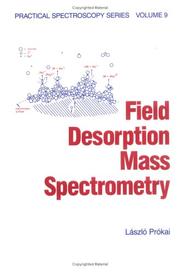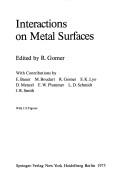| Listing 1 - 4 of 4 |
Sort by
|
Book
Year: 1959 Publisher: Köln: Westdeutscher Verlag,
Abstract | Keywords | Export | Availability | Bookmark
 Loading...
Loading...Choose an application
- Reference Manager
- EndNote
- RefWorks (Direct export to RefWorks)

ISBN: 0824783034 9780824783037 Year: 1990 Volume: 9 Publisher: New York Marcel Dekker
Abstract | Keywords | Export | Availability | Bookmark
 Loading...
Loading...Choose an application
- Reference Manager
- EndNote
- RefWorks (Direct export to RefWorks)
Book
Year: 2017 Publisher: Bruxelles: UCL. Faculté de pharmacie et des sciences biomédicales,
Abstract | Keywords | Export | Availability | Bookmark
 Loading...
Loading...Choose an application
- Reference Manager
- EndNote
- RefWorks (Direct export to RefWorks)
Au laboratoire de microbiologie de routine, le MALDI-TOF MS est devenu, depuis les années 2010, un outil incontournable pour l'identification de bactéries sur gélose. Il devance les méthodes conventionnelles notamment par sa rapidité, son exactitude et sa robustesse, et est bien plus rentable que celles-ci et la biologie moléculaire. En effet, il permet une identification dans la minute, et présente actuellement un taux d'identification à l'espèce autour de 95%. Des études récentes témoignent de taux de 98,2% pour les bactéries aérobies Gram-négatif, 70,2% pour les coques Gram-négatif exigeants, 94,7% pour les coques Gram positif, 83,7% pour les bacilles Gram-positif, 92,5% pour les bactéries anaérobies et 98,8% pour les levures. De plus, la distinction entre pneumocoque et streptocoques mitis/oralis et shigella et E. Coli, qui constituaient deux principales limitations, ont pu être surmontées. D'autre part, la seconde partie de ce travail se consacre aux autres domaines d'application du MALDI-TOF MS en microbiologie, en routine. Premièrement, il permet l'identification directe de bactéries d'hémocultures positives, avec un taux d'identification à l'espèce d'environ 80%. Enfin, le MALDI-TOF MS peut être appliqué à la détection de résistances aux antibiotiques, pouvant donner un résultat après 2 à 5 h, contre 18 à 24 h pour un antibiogramme. Mais les méthodes utilisées pour cela nécessitent encore davantage de validations et de standardisation avant d'être implantées en routine. Since the past seven years, the MALDI-TOF MS technology has become an unavoidable tool for bacterial identification of gelose cultures in clinical microbiology. It is among other factors more accurate, way less time-consuming, more robust than conventional methods, and more cost-effective than them and molecular biology methods as well. In fact, it allows a minute identification, and currently presents an identification rate about 96% at the species level. Recent studies show rates of 98.2% for aerobic Gram-negative bacteria, 70.2% for fastidious Gram-negative rods, 94.7% for Gram-positive cocci, 83.7% for Gram-positive rods, 92.5% for anaerobes and 98.8% for yeast. Moreover, the differentiation between Pneumococcus and Streptococcus mitis/oralis and between Shigella spp. And E. coli, two major limitations of the system, can be overcome. The second part of this work focuses on the other applications of MADI-TOF MS in routine microbiology. First of all, it enables direct identification from positive blood culture bottles, with and honorable rate of identification at the species level about 80%. Finally, it can be used for the detection of antibiotic resistance, which can give results within 2 to 5 hours, versus 18 to 24 hours with an antibiogram. However, the methods used to this purpose need more validations and standardization yet to be suitable for routine use.

ISBN: 354007094X 038707094X 3540373934 9783540070948 Year: 1975 Volume: 4 Publisher: Berlin Springer
Abstract | Keywords | Export | Availability | Bookmark
 Loading...
Loading...Choose an application
- Reference Manager
- EndNote
- RefWorks (Direct export to RefWorks)
Mechanical properties of solids --- Electronics and optics of solids --- 538.9 --- Physics of condensed matter (in liquid state and solid state) --- Metals --- Surface chemistry. --- Surfaces. --- 538.9 Physics of condensed matter (in liquid state and solid state) --- Surface chemistry --- Chimie des surfaces --- Métaux --- Surfaces --- METALS --- SURFACE CHEMISTRY --- SURFACE (CHEMISTRY AND PHYSICS) --- CHEMISORPTION --- ENERGY LEVEL --- AUGER PROCESS --- CATALYSIS, HETEROGENEOUS --- DESORPTION --- PHOTOELECTRIC EMISSION --- ELECTRON EMISSION --- SURFACES
| Listing 1 - 4 of 4 |
Sort by
|

 Search
Search Feedback
Feedback About UniCat
About UniCat  Help
Help News
News